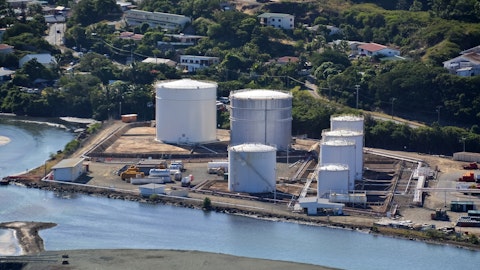Daniel Maudlin: Yeah. I mean, as you look at what goes in there, there’s a lot of very different applications. And we are, as Mike mentioned, doing mixed management in the CPI market. We’re also doing it in the other markets as well. So as we may be back away from some of the lower end commodity-type of business, for example, desulfurization, FGD, flue-gas desulfurization that we’ve talked about in the past, as we backed away from that, what’s left in there is going to be a higher average selling price. Now this average selling price we just did this quarter of $54.27, that’s pretty rich. Will that vary from that number? Probably. You can see — if you look quarter-to-quarter, it bounces around quite a bit and that’s a great number. Will it be sustainable? We’ll have to see what we have remaining in that other market category and what that ASP is going to be.
Michael Leshock: I appreciate all the detail. Thanks, guys.
Daniel Maudlin: Thank you, Michael.
Operator: Your next question is coming from Richard Evans at Mara River Capital Management.
Richard Evans: Hi, guys.
Michael Shor: Good morning.
Richard Evans: Just wondering on the mix management within chemical, what kind of pounds roughly are the high-value versus the commoditized? So we’ve got some idea of how much chemical might shrink to?
Michael Shor: Overall, when we look at what is kind of the volume alloys versus proprietary and specialty, maybe it’s a roughly 60-40, maybe a little higher on the volume-type alloys. Now if you segregate that down to just CPI, it may even be a bit more. We kind of view it as two pieces; half of it is commodity-type alloys, half of it is more specialty alloys and in some cases proprietary. So we’re certainly not getting out of the commodity alloys completely, but just some of those very low end commodity alloys that is highly competitive and really difficult to make much money on. We’ll focus our production capacity on the higher end products across the board.
Richard Evans: Okay. And then just on the inventory sort of headwinds that you are flagging, sort of bigger than you saw in Q4. Given cobalt flattened out, looking at the LME price of nickel, it’s clearly still going down, but it doesn’t seem to be dropping at a particularly high rate than it has done for all of ’23. So I’m just wondering why we’re getting incrementally higher and higher headwinds from nickel given the rate of decline doesn’t seem to have massively increased?
Michael Shor: Yeah. It’s been interesting, as I mentioned, this past year because there’s a lag impact of this as well keep in mind. So this past year, the headwind that we had $12.6 million was mostly cobalt. There was a little bit of nickel in there, but mostly cobalt. Cobalt has moderated, because as you mentioned, that price has stabilized, but nickel has continued to fall. So there’s always a lag impact. So what we’re expecting here in Q1 to be worse than Q4 is really the price decreases you saw even last quarter leading all the way up through this quarter. Even this month, nickel has dropped into the 7s. So for us, it’s particularly a sharp impact because we are all high end nickel and cobalt-based alloys. So we do feel this, in my opinion, much stronger than some of the other companies with lower in nickel or even stainless steel type of metals that they sell.
So we really see it very acutely and there is a lag impact. So what you’re seeing in Q1 of ’24, what we expect to see will be kind of the fall that we have already experienced in nickel and that could even spill into Q2. We’ll see where nickel goes from here.
Richard Evans: Yeah. I mean, I sort to get that, but I mean maybe something I have to take about offline. But if you look at — the start of ’23, nickel was what maybe $30,000 a ton. Now by the end of this — your reporting year, it already dropped to $18,000 a ton. It’s only dropped to $17,000, I’m just bemused why it’s getting so much worse incrementally?
Michael Shor: Yeah. It’s really just a lag impact. It peaked way back when about a year ago maybe here recently at $12.80 a pound and it’s really just continued to fall since then. So we’ve started feeling that incremental impact. But as that continues to fall, that will continue to build. And that’s the flip kind of from the cobalt impact, now we’re feeling it on the nickel impact. So $12 down into the 7s, that’s significant.
Daniel Maudlin: And remember, our six month approximate manufacturing lead time is on VIM product. And what we’re really dealing with here is the value of the scrap stream and what the value is now versus what the input cost was when it went in. So it does have something also to do with the lead time we have on our richest products.
Richard Evans: Okay. So if we see nickel price flatten out, it would be about six months from that flattening out. So when we see, in theory, no more headwind?
Daniel Maudlin: Yeah. That’s fair. Definitely more than one quarter, but probably six months would be a good estimate, yeah.
Richard Evans: Okay. And then just in terms of backlog, I mean, if I look back to 2018, 2019, your backlog as a percentage of annual sales was more like 60%, 65% of annual sales. Now it’s into the mid-to-high 80s of annual sales. As we move forward and things normalize, should we expect that backlog to trend back down towards sort of more 60% of sales — the sales grow? Maybe people become more comfortable not needing to order as far in advance?


